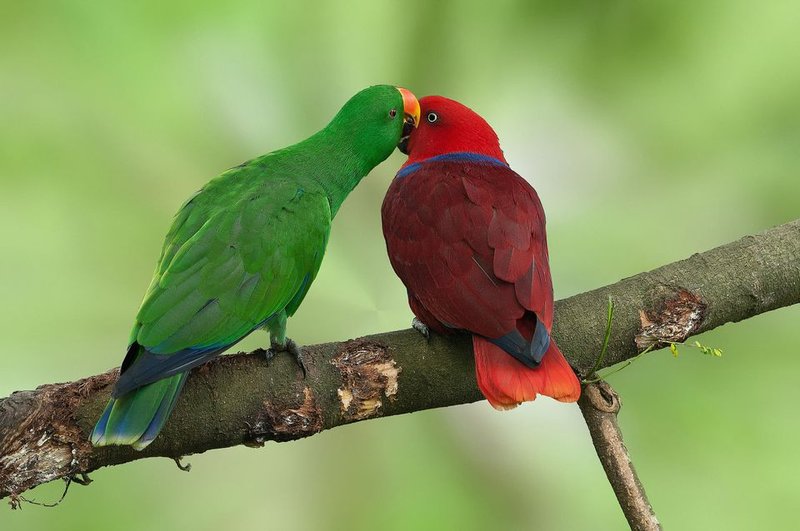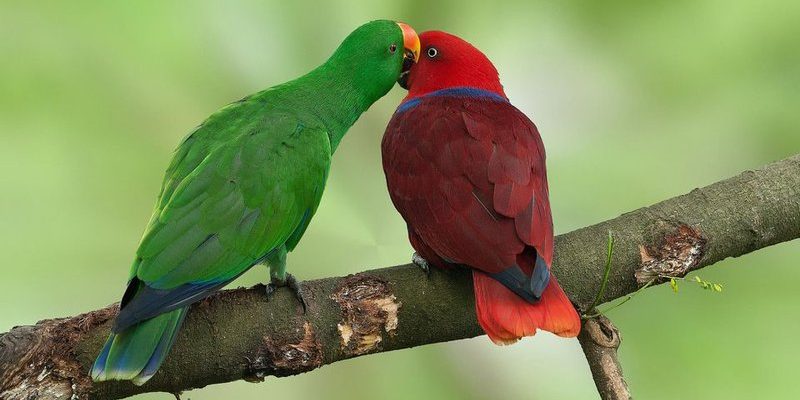
The Eclectus parrot, known scientifically as *Eclectus roratus*, is native to the lush forests of Australia, New Guinea, and several nearby islands. While their beauty and charm make them popular pets, the reality is that their wild populations face various challenges. Let’s dive into the world of Eclectus parrots to understand their conservation status, the threats they face, and what we can do to help them thrive.
Understanding Eclectus Parrots
Eclectus parrots are easily recognizable due to their sexual dimorphism; males are typically bright green, while females boast vibrant red and purple feathers. This striking difference is not just for show—it also plays a role in their mating rituals. Their diet primarily consists of fruits, seeds, and nuts, which they forage for in their natural habitat. They’re incredibly intelligent and known for their ability to mimic human speech, making them beloved companions for many.
These parrots are not just pretty faces; they are a vital part of their ecosystems. By eating fruits and seeds, they help with seed dispersal, contributing to the growth of new plants. However, their beautiful feathers and sociable nature have also made them targets for the pet trade, raising questions about their survival in the wild.
The Conservation Status of Eclectus Parrots
The Eclectus parrot is currently listed as “Least Concern” on the IUCN Red List. However, “least concern” doesn’t mean they’re out of danger. Their populations are not evenly distributed, and some local populations are indeed declining. Here’s where it gets a bit tricky—just because they’re not endangered globally doesn’t mean they’re safe everywhere. In some regions, habitat loss and illegal trapping are significant threats to their survival.
One of the biggest challenges for these birds is deforestation. As trees are cut down for agriculture and urban development, the natural habitats they rely on shrink. Without ample space to forage and nest, their numbers can dwindle quickly. This problem is especially prominent in areas where logging and land conversion are rampant.
Threats Facing Eclectus Parrots
Eclectus parrots face several threats that impact their survival in the wild. Here are some of the most pressing issues:
- Habitat Loss: As forests are cleared for agriculture or urbanization, the natural environments where these birds live are destroyed, making it harder for them to find food and shelter.
- Illegal Trapping: Their popularity as pets has led to illegal trapping in some areas, contributing to the decline of local populations.
- Climate Change: Changes in climate patterns can affect their food sources and nesting sites, further stressing their populations.
- Invasive Species: Predators like rats and cats can threaten their eggs and young chicks, leading to decreased survival rates.
Each of these factors compounds the challenges faced by the Eclectus parrot. Habitat destruction alone can lead to a rapid decline in their numbers, especially in areas where they breeding options are already limited.
The Role of the Pet Trade
The pet trade plays a significant role in the future of the Eclectus parrot. While many people relish the idea of having such a beautiful and intelligent bird as part of their family, it’s essential to consider ethical implications. Many birds sold in pet stores may come from wild populations, leading to concerns about over-exploitation.
Responsible breeding practices can help mitigate this issue, ensuring that pet owners are supporting sustainable efforts. If you’re thinking about getting an Eclectus parrot, consider adopting from a rescue organization or purchasing from a reputable breeder. This way, you can enjoy the joys of sharing your life with a parrot while also contributing to their conservation.
Conservation Efforts and What You Can Do
Luckily, various organizations and conservationists are working hard to protect the Eclectus parrot and their habitats. Here are some ways these efforts are taking shape:
- Habitat Restoration: Projects aimed at restoring native forests are crucial for the survival of these birds. Planting native trees and protecting existing habitats can help ensure they have the space they need to thrive.
- Education and Awareness: Raising awareness about the threats facing the Eclectus parrot helps build support for conservation initiatives. The more people know, the more they can help.
- Regulations on Trade: Laws and regulations can help control the pet trade, ensuring that birds are not taken from the wild unsustainably.
You can also do your part to help these birds. Supporting organizations dedicated to wildlife preservation, spreading awareness, or choosing to adopt rather than shop are tangible ways to make a difference. Every action counts, no matter how small.
So, are Eclectus parrots threatened or endangered? While they are currently classified as “Least Concern,” that status can easily change if we don’t take action to protect them. Their beauty is only matched by the complexity of their needs in the wild, and their survival depends on a collective effort.
By understanding the issues they face and supporting conservation efforts, we can help ensure that future generations enjoy the company of these remarkable birds. Whether you’re a budding birdwatcher or a longtime pet owner, remember that every little bit helps. Together, we can make a difference for the Eclectus parrot and all the beautiful wildlife that share our planet.

